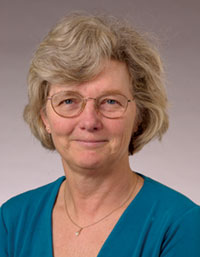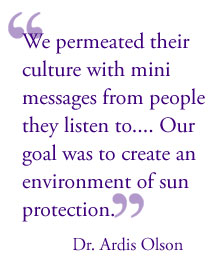
For Release: January 15, 2007
Contact: DMS Communications 603-650-1492
Skin Cancer Prevention Targets Teens

Sunsafe Logo
HANOVER, NH — Adolescents can learn to protect themselves from the sun to reduce their risk of skin cancer, but it takes a village. Engaging teens through community-wide messages from peer and adult role models encourages them to practice sun safety, report Dartmouth Medical School researchers in the January issue of Pediatrics.
Skin cancer, the most common cancer in the United States, is associated with sunburn and excessive solar exposure in early life. However, such protective practices as covering up or using sunscreen decline dramatically as children enter their middle school years and begin to establish their own health behaviors.

Dr. Ardis Olson
Building upon their prior SunSafe project that improved solar protection for young children through multi channel messages to parents and kids, the DMS team, members of the Norris Cotton Cancer Center, took the approach to middle schoolers.
Adolescents make choices based on what they see and hear around them; they are influenced by peers, school and family. "This was not just a classroom intervention. We permeated their culture with mini messages from people they listen to: coaches, science teachers, health educators, parents and friends," said project head Dr. Ardis Olson, professor pediatrics and of community and family medicine. "Our goal was to create an environment of sun protection."
The study, SunSafe in the Middle School Years, targeted 10 New Hampshire and Vermont communities not involved in the earlier studies and assessed habits of almost 2,000 children entering sixth through eighth grades. Teens and adults throughout the community were recruited to deliver multi-pronged safety messages that promoted protection through clothing, sunscreen or shade. In addition to informational materials, there were poster contests, bookmarks and a portable machine that allowed students to see skin damage not visible under normal light.

"This is the only study that looked at observed changes in kids, not just self reported," said Olson. The investigators visited teens at water activities, beaches and pools to see how much they were covered or using sunscreen, and compared the behaviors of those who received the interventions with those who did not.
Consistent messages to teens across varied venues made a difference. After two years, teens in the program practiced better solar protection. The researchers recommend that skin cancer prevention programs begin early in middle school and be integrated through multiple community channels. They also hope to promote protective clothing or shade, instead of sunscreen, when possible, since sunscreen can encourage more time in the sun.
Coauthors are Dartmouth colleagues Drs. Allen Dietrich and Bernard Cole, and Cecelia Gaffney, Pamela Starr and Jennifer J. Gibson.
-DMS-